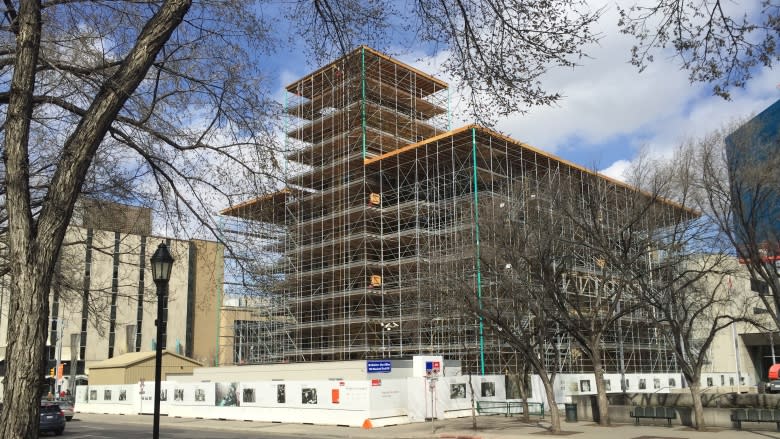Buy local? Calgary City Hall restoration to use sandstone from Poland, Spain and U.S.
Some of the sandstone to be used in the rehabilitation of Calgary's crumbling old city hall will be coming from across the Atlantic Ocean.
CBC News has confirmed the city is buying sandstone from suppliers in Poland and Spain as well as the U.S. for the $34-million project.
Last fall, city council passed a motion asking the city to examine re-opening a sandstone quarry in the Calgary area for the project.
Several quarries provided the original sandstone for the historic building, which opened in 1911.
Coun. Gian-Carlo Carra said that option was examined but the conclusion was that it's not going to work — at least not on the timeframe the old city hall project is on.
The former quarry in Edworthy Park was deemed to be the best potential site. But there are complications.
Carra said the Edworthy family donated the land to the city with the proviso it remain a park forever. To ensure that continues in perpetuity, the family also retained the mineral rights for the land.
Initial discussions were held but Carra said it wasn't going to be an easy deal to reach, if ever.
"It was going to be a bridge too far unless the city made some moves. And the city has made some moves and it still remains slightly a bridge too far because of those two things," said Carra.
Cheaper than local
Despite going off-shore and to the U.S. for its sandstone needs, the city says the cost will actually be cheaper than trying to find stone locally.
"I'm told that we're not going to be able to tell the difference between local stuff and ... so ... I guess that's the way it's going to have to be," Carra said.
The foreign content will be significant. There are over 15,000 pieces of sandstone on old city hall.
Even if local sandstone could be found, Mayor Naheed Nenshi said it would still have to be shipped somewhere else to be processed.
"It does make me sad," he said about the lack of local material being used.
"The fossils will be different in terms of what's in there. But our No. 1 priority is restoring that beautiful, historical building — that really important part of Calgary's tradition — and doing it quickly and cost efficiently."
The city says it will pay $3 million to the three foreign suppliers but no further breakdown or information about the companies is being provided at this time.
According to the city, the criteria for selecting suppliers was based on six equally-weighted requirements.
They are: price, technical fit, laboratory documentation, colour-calibrated photography, physical samples and cutting services.
It's actually not that unusual to mix stone from different parts of the world on a particular project.
'All about getting the right match'
Shawn Thibault, director of conservation for Ravenstone Masonry Conservation Inc. in Victoria, said it's all about getting the right match.
"To go and find a stone that's maybe not local but has all the same characteristics of the stone that is there, is really important. So to find a stone with that vein and stain or in the States or wherever it may be, it may be a better match than something that could be considered local," said Thibault.
But an equally important consideration besides finding the right stone is to install it correctly and look after the building, Thibault added.
"Even if it is the perfect match, if we don't do all the rest of that system correctly, i.e. we use the wrong mortars or decide to seal the stone or something like that, then we run the risk of damaging the stone that was good to begin with."
After the restoration project, Thibault said it's also important the city do what it can to prevent water from unnecessarily flowing onto the porous sandstone and keep things like salt from near-by concrete from touching the building.
Rather than be worried about where the sandstone is coming from, a local heritage group says the important thing is that the city is looking after a historically-significant Calgary landmark.
Landmark preservation also important
Cynthia Klassen is a past-president of the Calgary Heritage Initiative. She said it's understandable the city looked elsewhere for sandstone given that it would be challenging to re-open any of the old Calgary quarries due to the city having grown around them.
"So re-opening them and creating new industrial sites of that intensity in the middle of a city isn't something that we would be able to entertain currently," said Klassen. "It is an interesting conundrum that we find ourselves in."
But that said, Klassen isn't bothered that European and American sandstone will soon be part of old city hall.
"I don't see that as a big deal because the alternative would be to tear down old city hall and replace it with another glass and steel structure, similar to what we have all over downtown," said Klassen.
Carra plans to keep pushing the city's administration to find a local quarry solution because he says there are other sandstone buildings in Calgary that will need additional stone in the future.
Old city hall is expected to remain a construction site until mid-2020.
It has been designated as a legally protected heritage building by the city as well as by the federal and provincial governments.
- MORE ALBERTA NEWS | Bovine tuberculosis researchers hope breakthrough will lead to better test
- MORE ALBERTA NEWS | Former Calgary man Farah Mohamed Shirdon 1 of 2 Canadians added to U.S. terrorist list


